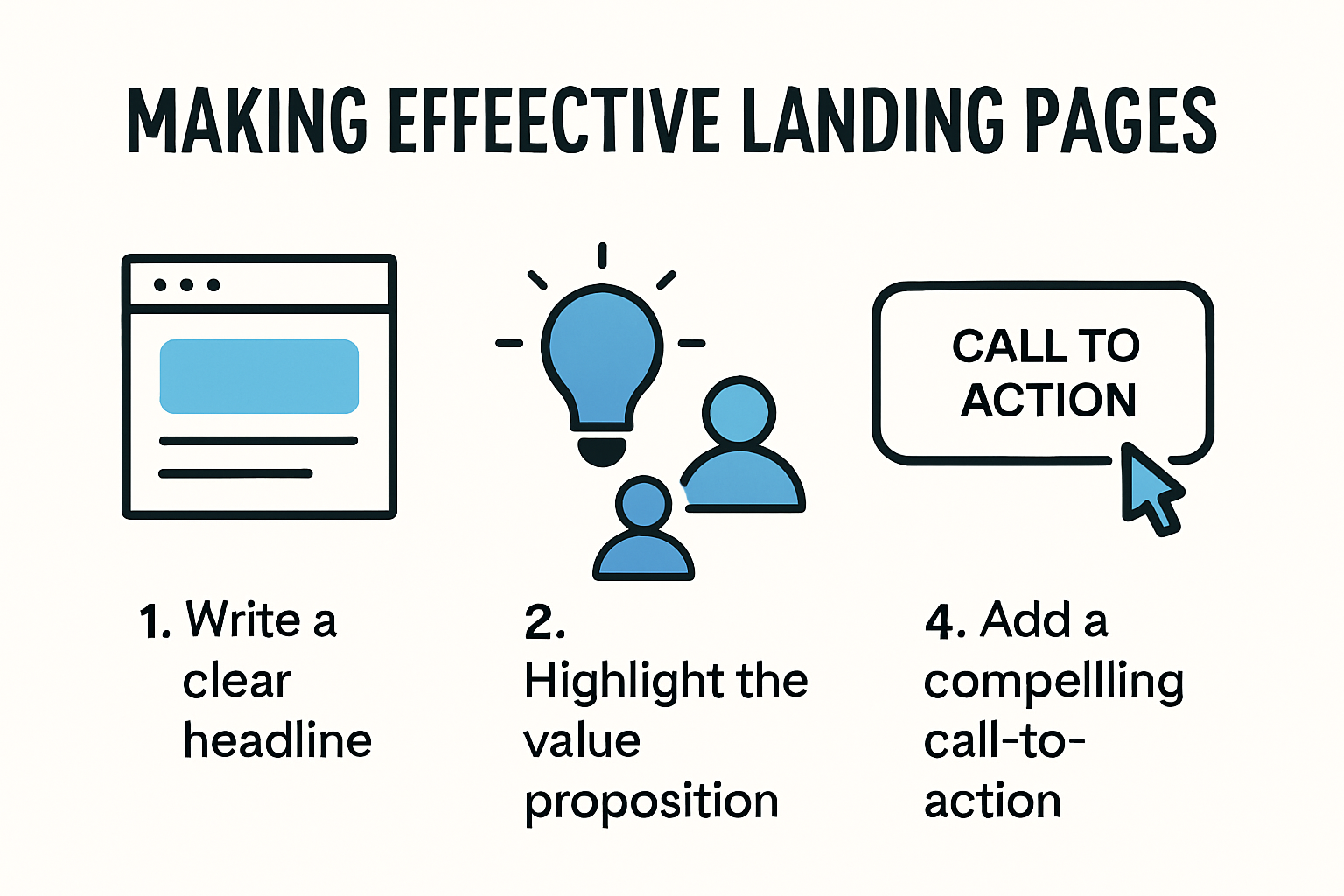Landing pages look simple, but they can make or break your business results. Studies show visitors decide whether to stay or leave a landing page in under 5 seconds. That seems harsh, right? Here’s the twist. The most effective landing pages are actually the least complicated ones—success comes from clarity, not flashy design. Ready to see why less really is more in 2025?
Table of Contents
- What Makes A Landing Page Effective
- Step-By-Step Guide To Building Landing Pages
- Best Practices For Different Business Roles
- Common Mistakes And How To Avoid Them
Quick Summary
| Takeaway | Explanation |
|---|---|
| Effective Visual Design Enhances Engagement | Simplified layouts with clear visual hierarchies promote better user comprehension and reduce cognitive load, making calls to action more compelling. |
| Compelling Messaging Drives Conversions | Engaging headlines and clear value propositions should address user pain points quickly, using benefit-focused language to connect emotionally with visitors. |
| Accessibility is Key to Broader Reach | Designing landing pages for inclusivity, including fast loading times and minimal form fields, can expand audience reach and improve conversion rates. |
| Strategic Goal Setting is Essential | Clear objectives and audience analysis are foundational to crafting landing pages that resonate with specific user needs and drive desired actions. |
| Regular Testing and Optimization Foster Success | Implementing tracking mechanisms and conducting A/B testing help refine elements of landing pages, ensuring ongoing improvements and higher conversion rates. |
What Makes a Landing Page Effective
Creating an effective landing page requires a strategic approach that goes beyond basic design. In 2025, businesses need to understand the critical elements that transform a simple web page into a powerful conversion tool. The goal is not just to attract visitors but to guide them toward a specific action with precision and clarity.
Visual Design and User Experience
The visual complexity of a landing page directly impacts user engagement and comprehension. Research analyzing web search interfaces reveals that simpler layouts are associated with higher learning success. This means your landing page should embrace clean, intuitive design principles that guide the user’s eye and reduce cognitive load.
Key visual elements that make a landing page effective include:
- Clear Visual Hierarchy: Strategically place key information so users can quickly understand the value proposition
- Minimalist Design: Remove unnecessary elements that might distract from the primary call to action
- Responsive Layout: Ensure the page looks perfect on desktop, tablet, and mobile devices
Color psychology plays a crucial role in landing page effectiveness. Different colors evoke specific emotions and can significantly influence user behavior. Blue might communicate trust, while red can create a sense of urgency. Choose colors that align with your brand and the emotional response you want to trigger.

Compelling Content and Messaging

Research on clinical trial recruitment websites demonstrated that unique visual storytelling can dramatically improve user engagement. Your landing page content must do more than inform - it must persuade and connect emotionally.
Effective landing pages typically include:
- Headline That Captures Attention: Create a powerful headline that immediately communicates the unique value
- Concise Value Proposition: Explain exactly what problem you solve in less than 10 seconds
- Social Proof: Incorporate testimonials, case studies, or trust signals that build credibility
The language should be direct, benefit-focused, and free from industry jargon. Speak directly to the user’s pain points and show how your solution provides relief.
Accessibility and Conversion Optimization
An analysis of web portals based on accessibility guidelines underscores the importance of creating landing pages that are inclusive and user-friendly. This means designing for all users, including those with disabilities, which not only expands your potential audience but also demonstrates corporate responsibility.
Critical accessibility and conversion elements include:
- Fast Loading Speed: Pages must load within 2-3 seconds to prevent user drop-off
- Clear Call to Action: Use contrasting colors and compelling microcopy for your CTA buttons
- Minimal Form Fields: Request only essential information to reduce friction
The most effective landing pages are those that balance aesthetic appeal with functional design, creating a seamless user experience that naturally guides visitors toward conversion. By focusing on visual clarity, compelling messaging, and inclusive design, businesses can create landing pages that not only attract attention but also drive meaningful action.
Step-by-Step Guide to Building Landing Pages
Building an effective landing page requires a methodical approach that transforms strategic planning into a compelling digital experience. This guide provides a comprehensive roadmap for creating landing pages that convert visitors into valuable leads or customers.
Strategic Goal Setting and Audience Analysis
Marketing research from the Digital Marketing Institute emphasizes that successful landing pages begin with crystal-clear objective definition. Before writing a single word or designing a layout, businesses must precisely identify their primary conversion goal.
Key steps in initial planning include:
- Target Audience Mapping: Create detailed personas understanding demographic, psychographic, and behavioral characteristics
- Conversion Objective Specification: Define exact action desired from visitors (purchase, signup, download)
- Competitive Landscape Assessment: Analyze similar landing pages in your industry to identify differentiation opportunities
Understanding your audience’s pain points, motivations, and digital behavior becomes the foundation for crafting a landing page that resonates and drives action. Each design and content choice should directly address your specific audience’s needs and expectations.
Content Creation and Persuasive Design
User experience research from Nielsen Norman Group indicates that visitors make critical decisions within seconds of landing on a page. Your content must immediately communicate value, build trust, and guide users toward the desired action.
Essential content development strategies include:
- Headline Optimization: Craft a compelling headline that communicates unique value proposition within 6-8 words
- Benefit-Focused Copywriting: Describe solutions from the user’s perspective, emphasizing transformative outcomes
- Visual Storytelling: Use images, icons, and graphics that quickly illustrate complex concepts
The most effective landing pages blend emotional appeal with logical argumentation. They tell a story that connects with users’ aspirations while providing concrete evidence of potential results.
Technical Implementation and Conversion Optimization
Conversion rate optimization studies from Unbounce reveal that technical execution significantly impacts landing page performance. Beyond aesthetics, the page must function seamlessly across devices and minimize user friction.
Critical technical considerations include:
- Mobile Responsiveness: Ensure perfect display and functionality on smartphones and tablets
- Page Load Speed: Optimize images and minimize code to achieve under 3-second load times
- Form Design: Create minimal, intuitive forms that request only essential information
Implement tracking mechanisms like Google Analytics to continuously monitor user behavior, allowing data-driven refinements. A/B testing different page elements can unlock incremental improvements in conversion rates.
Building an exceptional landing page is an iterative process. Success comes from combining strategic planning, compelling storytelling, and rigorous technical optimization. By following this systematic approach, businesses can create landing pages that not only attract attention but consistently convert visitors into valuable customers.
To summarize the process, here’s a table outlining the key steps to building an effective landing page and their focuses:
| Step | Key Focus |
|---|---|
| 1. Goal Setting & Audience Analysis | Define objectives, map personas, assess competition |
| 2. Content Creation & Persuasive Design | Optimize headline, benefit-driven copy, visual story |
| 3. Technical Implementation & Optimization | Mobile-friendly, fast load, simple forms, track data |
Best Practices for Different Business Roles
Landing pages are not one-size-fits-all tools. Different business roles require tailored approaches to maximize conversion potential and achieve specific organizational objectives. Understanding how to craft landing pages that resonate with unique professional perspectives can significantly enhance overall marketing effectiveness.
Marketing and Sales Professionals
Research from Toptal highlights the critical importance of creating landing pages that align directly with marketing and sales funnel strategies. For these professionals, landing pages serve as precision instruments for lead generation and customer acquisition.
Key considerations for marketing and sales landing pages include:
- Targeted Messaging: Develop hyper-specific content that speaks directly to pain points of target customer segments
- Performance Tracking: Implement robust analytics to measure conversion rates, bounce rates, and user engagement
- Lead Capture Optimization: Design forms that balance information gathering with minimal user friction
Marketing teams should focus on creating landing pages that tell a compelling narrative while providing clear pathways to conversion. The goal is to transform casual visitors into qualified leads through strategic content and design.
Project Managers and Team Leaders
GetResponse research indicates that project managers require landing pages that communicate complex information quickly and effectively. These professionals need landing pages that demonstrate value, credibility, and actionable insights.
Essential elements for project management focused landing pages include:
- Clear Value Proposition: Articulate project outcomes and organizational benefits within seconds
- Social Proof: Incorporate case studies, testimonials, and quantifiable results
- Process Visualization: Use infographics or flowcharts to explain project methodologies
The most effective landing pages for project managers balance technical credibility with emotional storytelling, helping stakeholders understand both the strategic and human elements of proposed initiatives.
Executive and Business Leadership
Mobile responsiveness research underscores the importance of creating landing pages that function flawlessly across multiple devices for executive audiences. Business leaders require landing pages that communicate sophistication, efficiency, and strategic thinking.
Critical design principles for executive-focused landing pages include:
- Minimal Design Complexity: Create clean, professional layouts that prioritize information clarity
- Strategic Storytelling: Connect individual solutions to broader business transformation narratives
- Data-Driven Credibility: Integrate meaningful metrics and performance indicators
Executives evaluate landing pages through a strategic lens, seeking solutions that demonstrate measurable business impact and innovative problem-solving approaches.
The art of creating effective landing pages lies in understanding the unique perspective of each business role. By tailoring content, design, and messaging to specific professional needs, organizations can develop landing pages that not only attract attention but drive meaningful business outcomes across diverse audiences.
Below is a table summarizing best practices for landing pages by business role, showing the distinct priorities for each:
| Business Role | Top Landing Page Priorities |
|---|---|
| Marketing & Sales | Targeted messaging, analytics, optimized lead forms |
| Project Managers & Team Leaders | Clear value, social proof, visualized processes |
| Executives & Business Leadership | Minimalism, strategic storytelling, performance data |
Common Mistakes and How to Avoid Them
Landing pages are powerful conversion tools, but even small missteps can dramatically reduce their effectiveness. Understanding and proactively addressing common pitfalls can transform a mediocre landing page into a high-performing digital asset that drives significant business results.
Messaging and Value Proposition Failures
User experience research from Nielsen Norman Group reveals that visitors make critical decisions within the first 3-5 seconds of landing on a page. Poorly constructed messaging can instantly discourage potential customers.
Common messaging mistakes include:
- Vague Value Proposition: Failing to clearly communicate unique benefits
- Overcomplicated Language: Using technical jargon that alienates potential customers
- Lack of Emotional Connection: Neglecting to address user pain points and aspirations
To avoid these pitfalls, businesses must craft messaging that is immediate, clear, and emotionally resonant. Your value proposition should answer the fundamental question: “What problem do you solve, and why are you the best solution?”
Design and User Experience Errors
Conversion optimization research from Unbounce highlights critical design elements that frequently undermine landing page performance. Visual complexity and poor user experience can create immediate friction for potential customers.
Key design mistakes to avoid:
- Cluttered Layout: Overwhelming visitors with too much information
- Inconsistent Branding: Misalignment between page design and overall brand identity
- Poor Mobile Responsiveness: Creating pages that don’t adapt to different device screens
Successful landing pages prioritize simplicity, visual hierarchy, and intuitive navigation. Every design element should purposefully guide users toward the desired conversion action.
Conversion Optimization Pitfalls
Conversion rate studies from ConversionXL demonstrate that technical and strategic errors can significantly reduce landing page effectiveness. The most sophisticated design cannot overcome fundamental conversion barriers.
Critical conversion mistakes include:
- Complicated Forms: Requesting excessive information that creates user friction
- Weak Call-to-Action: Using generic or passive language that fails to motivate action
- Lack of Social Proof: Missing testimonials, case studies, or trust signals
Effective landing pages reduce cognitive load, minimize user effort, and provide clear, compelling reasons to convert. This requires continuous testing, refinement, and a deep understanding of user psychology.
Avoiding these common mistakes requires a holistic approach that combines strategic messaging, thoughtful design, and data-driven optimization. Successful landing pages are not created once but continuously evolved through careful analysis and iterative improvements. By understanding and proactively addressing potential pitfalls, businesses can create landing pages that not only attract attention but consistently drive meaningful conversions.
Frequently Asked Questions
What are the key components of an effective landing page?
An effective landing page includes a clear visual hierarchy, compelling content and messaging, and accessibility for all users. Simplified design and an engaging value proposition enhance user experience and drive conversions.
How do I create a landing page that converts?
To create a landing page that converts, set specific goals, understand your audience, focus on persuasive design and content, ensure mobile responsiveness, and continuously test and optimize your page.
Why is visual design important for landing pages?
Visual design is crucial because it affects user engagement and comprehension. A clean and intuitive layout reduces cognitive load, making key information easy to find and calls to action more effective.
What common mistakes should I avoid when designing landing pages?
Common mistakes to avoid include vague messaging, cluttered layouts, poor mobile responsiveness, complicated forms, and weak calls to action. Each element of the landing page should guide users toward the desired action clearly and efficiently.
Transform Your Landing Page Strategy With Smart Team Management
Are you tired of spending endless hours crafting landing pages, only to see underwhelming results? The article highlighted how critical time, clarity, and streamlined workflows are to building landing pages that truly convert. Many business leaders miss out on meaningful growth because scattered processes, unclear roles, and repetitive admin tasks slow everything down. Gammatica.com recognizes these pain points and provides a way to organize, automate, and elevate every project, including your high-stakes landing page campaigns.

Ready to achieve more with less effort? Unlock the power of AI-driven project management, automated checklists, and unified team collaboration. Let Gammatica’s platform help you centralize every step of your landing page creation, from brainstorming to launch. Experience how task automation, CRM, and easy integrations can boost your productivity now. Visit Gammatica.com to simplify your next landing page—and every project after it.



